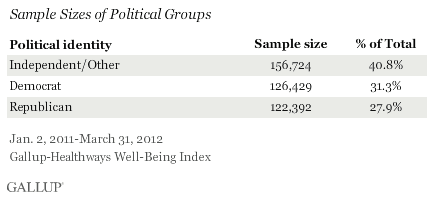PRINCETON, NJ -- Americans who self-identify as Republicans have higher levels of well-being than do Democrats, while both Republicans and Democrats have higher well-being than independents.

These findings are based on an analysis of more than 400,000 Gallup-Healthways Well-Being Index interviews conducted since the start of 2011. Americans' party identification is based on their responses to Gallup's standard political party question: "In politics, as of today, do you consider yourself a Republican, a Democrat, or an independent?"
The differences in well-being among Republicans, Democrats, and independents are small on an absolute basis, but statistically significant, given the large sample size this research uses, and would occur infrequently by chance alone. The differences are also notable, given that Well-Being Index scores do not vary widely across subgroups of the U.S. population. For example, there is a maximum 5.2-percentage-point difference in well-being by racial group, a maximum 3.2-point difference by age group, and a 0.1-point difference between genders.
Well-Being Higher for Republicans Across Most Areas of Well-Being
The Well-Being Index score comprises six sub-indexes, which measure a wide variety of health and well-being issues. Republicans enjoy at least modestly higher scores than Democrats on five of the six sub-indexes. Democrats score slightly higher on the Life Evaluation Index. This difference could reflect the political impact of having a Democrat in the White House.
Republicans do significantly better than independents across all six well-being sub-indexes. Democrats score higher than independents on four of the six, the exceptions being the Work Environment and Physical Health sub-indexes.

Republicans outperform Democrats the most in terms of their workplace perceptions, access to basic necessities, and physical health. Differences between the groups on two other key areas of well-being -- emotional health and healthy behaviors -- are smaller, but statistically significant.
The notable exception to the general pattern is found in life evaluation, a measure on which Democrats do best. The Life Evaluation Index classifies Americans as "thriving," "struggling," or "suffering," according to how they rate their current and future lives on a ladder scale with steps numbered from 0 to 10, based on the Cantril Self-Anchoring Striving Scale. The overall Life Evaluation Index score is calculated by subtracting the percentage of suffering Americans from the percentage of thriving Americans.
Independents -- who are less tied to the traditional political system than those who identify with either of the two major parties -- lag behind Republicans most in terms of their life ratings and access to basic necessities.
Controlling for Demographic Differences
Previous research has shown that political identity is related to age, gender, race and ethnicity, region and state of the country, socioeconomic status, marital status, and childbearing status. Well-being is also related to these variables, making it likely that some of the differences by partisan group are being driven by the underlying demographic characteristics of each group. To investigate that hypothesis, Gallup controlled for all of these characteristics.
The results show that the same basic pattern of differences persists even after these demographic controls are put in place, albeit on a muted basis. In other words, Americans who identify as Republicans have higher overall well-being than what would be expected on the basis of their demographics alone.
Implications
Political identification in the United States today is highly intertwined with many aspects of American social and economic life. For example, blacks, Hispanics, and Asians are significantly more likely than whites to identify as Democrats; women are more likely to identify as Democrats than are men, and those who are married are more likely to identify as Republicans than those who are single. This analysis of Well-Being Index data reveals there are significant differences by political identity in well-being as well. Republicans have the highest well-being, above and beyond what would be explained by differences in well-being by demographics. Why this is the case is not known for sure, although one possibility may relate to religion; Republicans are more religious in general than independents or Democrats, and Gallup has shown in previous analyses that religiosity has a significantly positive relationship to well-being.
About the Gallup-Healthways Well-Being Index
The Gallup-Healthways Well-Being Index tracks well-being in the U.S., U.K., and Germany and provides best-in-class solutions for a healthier world. To learn more, please visit well-beingindex.com.
Survey Methods
Results are based on telephone interviews conducted as part of the Gallup-Healthways Well-Being Index survey Jan. 2, 2011-March 31, 2012, yielding a random sample of 405,554 adults, aged 18 and older, living in all 50 U.S. states and the District of Columbia, selected using random-digit-dial sampling. Of this sample, self-identified independents/other respondents made up the plurality (40.8%), with slightly more than one-quarter each for Democrat and Republican respondents.

For results based on the sample of these three religiosity classes of national adults, one can say with 95% confidence that the maximum margin of sampling error is less than ±0.5 percentage point for each group.
Generalized linear model analysis was used to estimate marginal scores all the six Indexes after controlling for age (in years), gender, race/ethnicity, marital status, education (number of years), log of income, and region of the country.
Interviews are conducted with respondents on landline telephones and cellular phones, with interviews conducted in Spanish for respondents who are primarily Spanish-speaking. Each sample includes a minimum quota of 400 cell phone respondents and 600 landline respondents per 1,000 national adults, with additional minimum quotas among landline respondents by region. Landline telephone numbers are chosen at random among listed telephone numbers. Cell phone numbers are selected using random-digit-dial methods. Landline respondents are chosen at random within each household on the basis of which member had the most recent birthday.
Samples are weighted by gender, age, race, Hispanic ethnicity, education, region, adults in the household, and phone status (cell phone only/landline only/both, cell phone mostly, and having an unlisted landline number). Demographic weighting targets are based on the March 2011 Current Population Survey figures for the aged 18 and older non-institutionalized population living in U.S. telephone households. All reported margins of sampling error include the computed design effects for weighting and sample design.
In addition to sampling error, question wording and practical difficulties in conducting surveys can introduce error or bias into the findings of public opinion polls.
For more details on Gallup's polling methodology, visit www.gallup.com.
